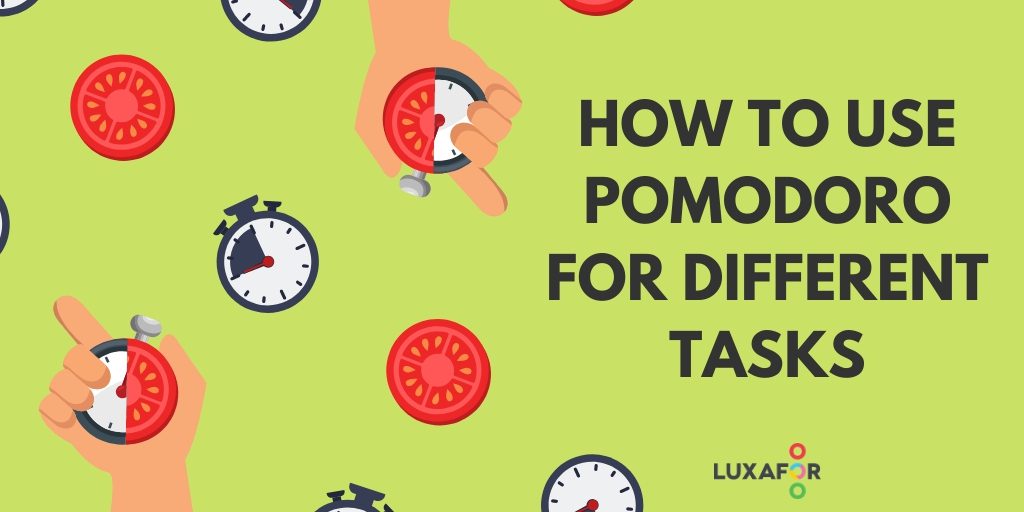The Ultimate Guide How To Use Pomodoro Technique When Working On Different Tasks
The Ultimate Guide How To Use Pomodoro Technique When Working On Different Tasks
- Updated on: June 20, 2024
Luxafor is known for its expertise with pomodoro timers and the best use as well as practical tips for incorporating Pomodoro Technique in your work and with your smart gadgets. Their Pomodoro Timer is a unique time management gadget designed to help individuals and teams stay focused and organized by utilizing the Pomodoro Technique.
Luxafor Pomodoro Timer offers a practical and user-friendly approach to implementing the Pomodoro Technique, potentially improving focus, reducing distractions, and promoting better time management with selected pomodoro intervals for your work and rest sessions.
What if you could get an extra hour in a day – wouldn’t that be awesome?
Unfortunately, we don’t have the knowledge (yet) to share any successful time-warping methods, however, there is a widely used technique that allows you to hack your time management to its full potential.
It’s the Pomodoro technique. This popular method for executing tasks can help you power through distractions, focus better, and simply get things done in short amounts of time (pomodoro intervals), while also taking frequent breaks to rewind, overall improving productivity. Best of all, it’s easy.
What is the Pomodoro Technique?

Source: Unsplash
The Pomodoro – you’ve heard of it. Invented by an Italian Francesco Cirillo, 30 minutes, the Italian word for tomato, was tomato shaped… Ehm, something like this, right? The Pomodoro technique is widely known for dividing any task into blocks of 25-minute work and 5-minute rest. However, if you know just that, and you think you couldn’t get much done in just 25 minutes – 30 minutes, you might as well conclude that this method is simply not for you. But it is.
Turns out, Francesco Cirillo developed the method for studying and came up with the average and optimal length: 25 minutes of focus. The Pomodoro technique is simply a cyclical system, where your work time is in (relatively) short sprints, which makes sure you’re consistently productive. You have to take in mind that the length of the sprints depends on the individual and the type of the task.
Some people prefer 15-minute sessions, especially if they have learning difficulties or concentration issues. Alternatively, some people prefer 50-minute sessions with a 10-minute break. And while his invention is nothing extraordinary, it is genius in its simplicity, and what most people don’t know is versatility.
How to use the Pomodoro Technique?
Source: Luxafor
The Pomodoro methodology is fairly simple. When faced with any important task or series of tasks, break the work down into short, timed intervals (called “Pomodoros”) that are spaced out in short amounts of time. Then after every 4 (or so) Pomodoros take a longer break of 15 – 30 minutes, whatever it takes to make you feel recharged and ready to start another work session.
The typical workflow via the Pomodoro technique looks like this:
- Choose a task you want to work on.
- Set the timer to 25 minutes, the standard pomodoro duration.
- Work on the task until the timer rings, then check off your task in your to-do list.
- Take a short break of 5 minutes to do something not related to work like stretching, doodling, or making a call.
- After every 4 pomodoros, take a longer break of 20-30 minutes. This will help you clear your head, recollect your thoughts, and rest before the next batch of Pomodoro-style work.
This trains your brain to focus for short periods and helps you stay on top of deadlines or constantly-refilling inboxes. With time it can even help improve your attention span and concentration.
What do I need to start ?
Source: Luxafor
Luckily, you don’t need much to start executing your tasks the Pomodoro way. You’ll need:
1. A timer.
While a regular timer might be too much trouble to be manually set up for interchanged pomodoro intervals of 25 and 5 minutes, plenty of Pomodoro timers out there that will help you manage your time. Check out our 11 top picks on the best free Pomodoro timers.
2. A website blocker (or very strong willpower).
If you struggle with social media addiction, then a website blocker is a must. Our top pick – StayFocusd allows you to set limitations on how much time you spend on certain sites, so you can browse social media for only, let’s say, 15 minutes per day. Spent all of your long break on Facebook? No more Facebook for you then. Or you might simply (just a suggestion)… not go on social media while working on something?
3. A physical reminder.
Our team at Luxafor has been trying out Pomodoro for quite a time, and here’s what we discovered: after a while, that countdown in your browser can become just a bunch of moving meaningless numbers. You can sort of become immune to the significance of Pomodoro.
That’s why we’ve come to realize that nothing quite does the trick as an outer, physical reminder of the Pomodoro technique. You can do it with a simple post-it reminder, or maybe put it down in your to-do list to complete, for example, six Pomodoros. Or you can invest in an actual Pomodoro timer that you can set up and configure just the way you want via software.
Source: Luxafor
This lightweight gadget really comes in handy, when you want to have a physical reminder that reminds you to give your undivided attention to the work task at hand. You can set up custom intervals and custom light patterns for notifications – without any annoying ticking and ringing sounds.
What if I get distracted?
Source: Luxafor
Ok, say, you’ve blocked your websites and set the timer off. But it’s likely a coworker will pass by with a question or from time to time you’ll have to take that urgent call. What then?
It’s worth noting that a Pomodoro is an inseparable unit of work, meaning that if you do get distracted mid-session, you’ll either have to end the Pomodoro there (starting a new one later), or you’ll have to postpone the distraction until the Pomodoro session is over.
Yes, partial Pomodoro doesn’t count. And there is science behind that, as according to one study, it takes around 23 minutes to refocus after an interruption – almost a whole Pomodoro! So if you let a distraction take your focus away from your current work task, it is an unproductive session. Harsh? Maybe. But that indeed pushes you to get things done.
Interruptions are only uncontrollable by interpretation, but we can take control and deal with them in ways that best encourage us to remain productive. After all, cannot that “urgent” thing wait around 25 minutes or less? Emails, questions, and phone calls can almost certainly be postponed until a break or a session that can deal specifically with them.
Essentially, what the Pomodoro technique teaches you is managing distractions in a way that boosts productivity and enables you to take control of your time. To deal with unwanted distractions beforehand and effectively manage your priorities, Francesco Cirillo suggests the “inform, negotiate, and call back” strategy:
- Inform the other (distracting) party that you’re working on something right now.
- Negotiate a time when you can get back to them about the distracting issue in a timely manner.
- Schedule that follow-up immediately.
- Call back the other party when your Pomodoro is complete and you’re ready to tackle their issue
Is the Pomodoro technique for me?

Source: Unsplash
The technique is great for office workers as they can use the structured format to work through their to-do lists. It can also help manage distractions during the work day. The technique is easy to implement into the typical working day. Chris Winfield believes that a 40-hour workday may be reduced to 16,7 hours.
It is often used by students to help them focus during their studies. Because students are famous for procrastinating, the strategy can help them develop discipline and remain on top of their schoolwork. The Pomodoro technique requires you to choose a focus point for each session by establishing a goal and focusing completely on it. This concentration assists in completing things.
The Pomodoro technique is also very popular with freelancers as it helps to ensure they deliver quality on time and at a profit. It encourages you to take a real break from what you are doing and move around. This helps you to remain fresh throughout the day, inspiring creativity and quick thinking. Often writers use the technique to track their progress and to maintain focus.
The Pomodoro technique is ideal for daydreamers and those who are often interrupted. It can also help people who have a lot of tiny tasks to accomplish or those who have a long job to do since it helps them to focus on one task at a time and break a large project into manageable chunks of work. The system is remarkably adaptable to different kinds of work.
Mastering the Pomodoro technique for specific tasks

Source: Unsplash
The Pomodoro technique is very versatile and adaptable to the specific needs of your task, personality, and profession. It’s very remembering that the length of sessions and breaks are not set in stone. While trying out Pomodoro, you’ll probably notice that you’d like to use different length sessions for various activities. However, remember that Pomodoro is only a technique on how you focus on a task at hand, not how you organize or prioritize your work time.
The best ways how you can decide on your task management:
- Do a larger task over several Pomodoros.
- Group up smaller tasks of similar nature in one session.
Smaller tasks are easier to understand and estimate. However, for bigger tasks, you should try breaking them down into smaller components, and then apply Pomodoro. Any task that will take more than 5 or 6 pomodoros to complete should be broken down into tiny parts.
For example, replying to emails may be less intensive, and depending on the volume you might count it as a 10-minute or 15-minute Pomodoro session. Or you could group it up with other administrative and communication work for a full 25-minute interval. A large task like creating an analysis report should be divided into smaller tasks like getting data, interpreting data, and putting it together in a report. And each of them will require its own Pomodoros.
You can even change the duration of a session to fit into the time you have available. In some cases, people will assess that they only have 20 minutes before they need to leave. But that shouldn’t be an obstacle, as you could just do a 15-minute session instead!
Also, you have to really tune into yourself and consider which time of the day is the most productive for certain tasks. Are you more energetic in the morning or in the afternoon? Use that to help you determine a session length that suits you and the task. Don’t forget that it can change for different tasks or due to other factors.
How long should the sessions for different tasks be?
While you could stick to the classic intervals of 25-minute work and 5-minute break just because it’s easier, you might reconsider it to suit your specific needs.
How to understand how many minutes you need for each task? Experiment with the Pomodoro. Take up one day where you do all your tasks via the Pomodoro. Our suggestion is to:
- Group up tasks or break them down in smaller ones.
- At first try the classic Pomodoro technique workflow throughout the whole day.
- See how the session fits different tasks.
Make note of these things: Did you finish the task before the timer had ended? Or did you feel like you needed a couple of more minutes into the focus state? These are some serious questions to consider if you want to tailor the Pomodoro technique to fit any type of work you do.
Some useful Pomodoro intervals for different activities:
- Emails, calls, communication
10-15 minute Pomodoro, 3-minute break, depending on the volume.
- Studying, analyzing
25-minute Pomodoro, 5-minute break
- Writing and other in-focus creative tasks
25-30 minute Pomodoro, 5-minute break, depending on your individual flow state.
- Creative work like designing, editing
45-50 minute Pomodoro, 10-15 min break, depending on your individual flow state.
- Meetings, brainstorming
25-30 minute Pomodoro, 5-minute break (repeated until you’ve reached the goal of the meeting)
These recommended time intervals for Pomodoro will merely give you an idea of the amount of time you could spend on such tasks, and it’s possible that the optimal length of your individual focus time will vary. Some settle for 50-minute work/10-minute break, others find 35/7 to be just perfect, and one study suggested the ratio of 52 minutes on, and 17 minutes off. However, according to several studies, one session of work shouldn’t exceed 52-60 minutes, as it’s only natural we lose focus after that.
Some final words
So, to sum it up, the key to mastering the Pomodoro technique is understanding the fluctuations in your own flow states and tailoring the Pomodoro intervals to that. However, when you want to start using the Pomodoro, it makes it so much easier if you just stick to the classic 25/5 system and see how that works out.
Also, it’s important to note that Pomodoro is a technique that aids your productivity, not a set of rigid rules. If you’re really into that flow, and the timer goes off, it’s OK to round up your work and then take a break. Ultimately, the goal of executing tasks the Pomodoro way is to help you effectively get into the zone, while also taking longer breaks to recharge.
The more habitually you use it, the better it is for your productivity, but by no means the technique needs to be used at all times to be effective. If you can’t apply the technique all day, that is no reason to completely give up on it. Just look at your to-do list, and determine the tasks and the most convenient times of the day when you can use the Pomodoro technique efficiently. After that, you should have no obstacles to Pomodoro your way out of procrastination and into productivity!
Do you want to build and maintain new habits? Get your free PDF version of the Don't Break The Chain calendar and start today!
The Pomodoro Technique is a time management method that breaks work into intervals, traditionally 25 minutes in length, separated by short breaks. These intervals are named pomodoros after the tomato-shaped kitchen timer originally used.
- Improved focus and concentration: By breaking work into smaller chunks, you can maintain better focus.
- Increased productivity: Regular short breaks can prevent burnout and increase overall efficiency.
- Better time management: The technique helps you track time spent on tasks and identify time-wasting activities.
- Reduced stress: Regular breaks can help manage stress and prevent overwhelm.
- Experiment with time intervals: Some people find that different time intervals work better for them.
- Use a Pomodoro timer app: There are many apps available to help you track your time.
- Combine with other time management techniques: The Pomodoro Technique can be combined with other methods like time blocking or the Eisenhower Matrix







